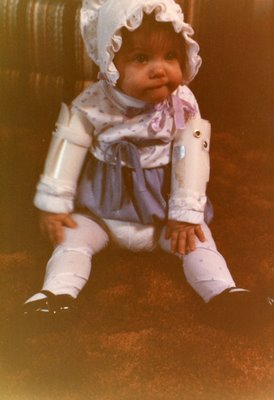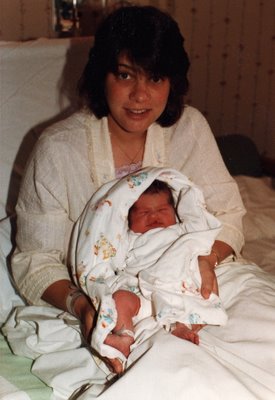Please keep Operation Smile and their mission in your prayers. Thank you.
Operation Smile
Thursday, May 25, 2006
Here is a final story from OS that I would like to leave you with...
Just five years old and already I know about rejection, denial and disappointment. It’s a hard lesson for a child like me whose only desire is to be normal. Through no fault of my own, I was born with a disfiguring cleft lip. Outside of our home, my mother says I would duck and cover my head since it hurt me so much to be stared at. I love to play baseball though, and it took a lot of courage for me to join the other village kids when they played because of how much they teased me.Every night before going to bed, I would get on my knees and pray for a miracle that would make me look just like all the other kids. My prayers were answered. During the Operation Smile medical mission to Barinas, Venezuela, I was one of more than 160 children selected for surgery. When my father saw me in the recovery room, he said, “I feel joy, much joy. I thank all the doctors. May they keep performing this good work, not only for my child, but for all the children who need it.”
www.operationsmile.com
Over the course of this semester I have learned so much about Cleft Lip and Palate. I thought I already knew everything I need to know but I found that that wasn't the case at all. I now realize the growing need of children who are less fortunate and need our help to answers their prayer.
If you ever need more information you can always go to
www.operationsmile.com

I was born with a cleft lip in Kaptrit, a small village in western Kenya. My parents didn’t know that the repair of my lip was possible, and many of the children in our village were afraid of me. When I was 13, my family learned from our neighbor, Joseph Zewedi, that Operation Smile doctors would be providing surgery in Nakuru. Unfortunately, my parents didn’t have enough money for the trip to the hospital. Kind-hearted Joseph started a collection in the village for the money — about $3.50 — for a one-way bus ticket to the mission site. Joseph raised the funds, and he and I began our eight-hour journey to Nakuru.
Three years later, my mother confessed that she never believed my lip would actually be repaired during the medical mission. She wanted the volunteers of Operation Smile to know that she is eternally grateful. So am I. Now, the children in my village not only accept me, they believe I hold some kind of magic. I have more friends than ever.
Here are some stories from the children. If you want to see more go to www.operationsmile.com
Just five years old and already I know about rejection, denial and disappointment. It’s a hard lesson for a child like me whose only desire is to be normal. Through no fault of my own, I was born with a disfiguring cleft lip. Outside of our home, my mother says I would duck and cover my head since it hurt me so much to be stared at. I love to play baseball though, and it took a lot of courage for me to join the other village kids when they played because of how much they teased me.
Every night before going to bed, I would get on my knees and pray for a miracle that would make me look just like all the other kids. My prayers were answered. During the Operation Smile medical mission to Barinas, Venezuela, I was one of more than 160 children selected for surgery. When my father saw me in the recovery room, he said, “I feel joy, much joy. I thank all the doctors. May they keep performing this good work, not only for my child, but for all the children who need it.”
Wednesday, May 24, 2006
Tuesday, May 23, 2006
Tuesday, May 09, 2006
Monday, May 08, 2006
Currently Operation Smile is in Ninh Thuan, Vietnam. They have fifty Operation Smile medical and non-medical volunteers in the city of Ninh Thuan. This is the first Operation Smile mission conducted in this city.
Sunday, May 07, 2006
Saturday, May 06, 2006
Here is some information from http://www.cleftline.org/publications/bonegraft.htm
Bone Grafting the Cleft Maxilla
Bone grafting in the dental ridge of the upper jaw (maxilla) is now standard, reliable treatment for patients with facial clefts. Bone grafting is an operation which involves taking a small amount of bone from one place (usually the hip, head, ribs, or leg) and placing it in the area of the cleft near the teeth. The procedure is employed to accomplish the following four goals:
To provide support for unerupted teeth and teeth next to the cleft.
To provide support for the lip and nose and to improve symmetry.
To form a continuous upper gum (alveolar) ridge, creating a more natural appearance and stability to the ridge.
To improve the stability of the front part of the roof of the mouth (premaxilla), if a bilateral cleft is present.
Bone grafting is a useful procedure and is most successful in patients under 10 years of age and as early as 5 to 6 years of age as the front incisor teeth are erupting. The overall erupting varies from child to child but usually is completed between the ages of 10 and 12. If the bone graft is placed after the permanent teeth have erupted, it will be too late to achieve goal number one above, although it may be useful toward achieving the remaining three goals.
Older patients may benefit from a bone graft but have less chance of total success. If the patient is a smoker, has a systemic disease such as diabetes, or has poor oral hygiene, the risk that the graft may fail increases even more.
Once the bone graft has been placed, there are three options that may be considered to replace any missing teeth in the area of the graft. These are: 1) moving adjacent teeth into the bone graft; 2) prosthetic replacement (dental bridge); or 3) dental metallic bone implants. The best option for an individual patient is best decided by the dental specialists on the cleft palate team.





